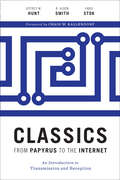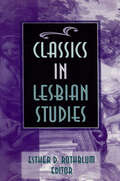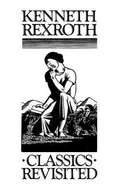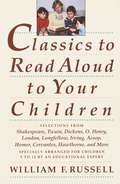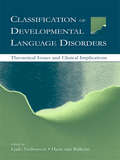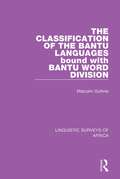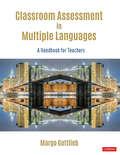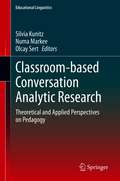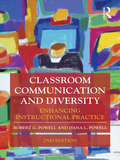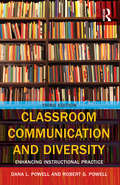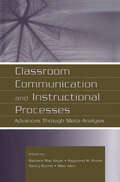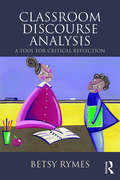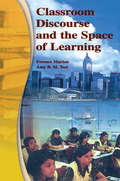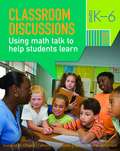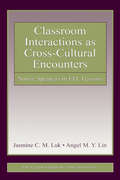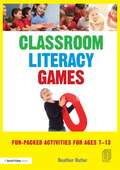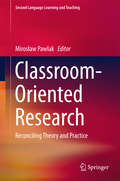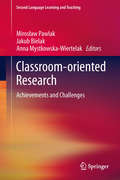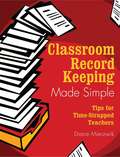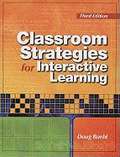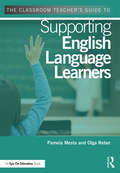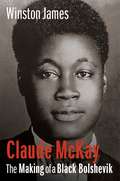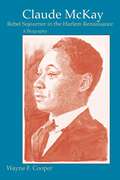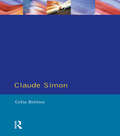- Table View
- List View
Classics from Papyrus to the Internet: An Introduction to Transmission and Reception (Ashley and Peter Larkin Series in Greek and Roman Culture)
by Jeffrey M. Hunt R. Alden SmithA &“valuable and useful&” history of the efforts and innovations that have kept ancient literary classics alive through the centuries (New England Classical Journal). Writing down the epic tales of the Trojan War and the wanderings of Odysseus in texts that became the Iliad and the Odyssey was a defining moment in the intellectual history of the West, a moment from which many current conventions and attitudes toward books can be traced. But how did texts originally written on papyrus in perhaps the eighth century BC survive across nearly three millennia, so that today people can read them electronically on a smartphone? Classics from Papyrus to the Internet provides a fresh, authoritative overview of the transmission and reception of classical texts from antiquity to the present. The authors begin with a discussion of ancient literacy, book production, papyrology, epigraphy, and scholarship, and then examine how classical texts were transmitted from the medieval period through the Renaissance and the Enlightenment to the modern era. They also address the question of reception, looking at how succeeding generations responded to classical texts, preserving some but not others. This sheds light on the origins of numerous scholarly disciplines that continue to shape our understanding of the past, as well as the determined effort required to keep the literary tradition alive. As a resource for students and scholars in fields such as classics, medieval studies, comparative literature, paleography, papyrology, and Egyptology, Classics from Papyrus to the Internet presents and discusses the major reference works and online professional tools for studying literary transmission.
Classics in Lesbian Studies
by Esther D RothblumClassics in Lesbian Studies takes a major step in giving the lesbian experience its own unique voice within scholarship and the larger world society. Thus, it is devoted exclusively to the lesbian experience and serves as a vehicle for the promotion of scholarship and commentary on lesbianism from an international perspective. Not only does it ensure that “classic” pieces are not forgotten by new generations of students and scholars, it also spurs further lesbian research, writing, theory, and scholarship.In Classics in Lesbian Studies, you are introduced to descriptive, theoretical, empirical, applied, and multicultural perspectives in the field of lesbian studies. Interdisciplinary, the book presents pieces from various academic areas in multiple formats, including personal accounts, poetry, editorials, debates, and commentaries. For your convenience, the chapters are organized primarily across four categories: identity, history and literature, physical and social sciences, and “back to lesbian politics.” You will find the discussions of the following issues and subjects provocative and insightful: ways black women in the diaspora construct and name their sexual and romantic feelings for other women lesbian identity formation in a changing social environment how lesbians maneuver in the dominant culture and their own subculture lesbianism as a political movement the experiences of lesbian adolescents teaching lesbian studies lesbians and societal institutions, including the work place, the media, the political arena, the legal system, and religion using lesbian-feminist scholarship to reexamine women's lives in the pastStudents, scholars, lesbian feminists, and others interested in lesbian studies will find Classics in Lesbian Studies a vital examination of lesbianism since its grass roots. Not only does it consider the progress made since the initial days of fighting for liberation, it also explores a more distant, repressed past and anticipates future possibilities lying before us. This powerful, insightful collection is sure to become a classic as it grapples with virtually all aspects of lesbianism, from its inception as a political movement to its identity as a lifestyle choice to its implications of community.
Classics Revisited
by Kenneth Rexroth Bradford MorrowThe history of, and comments about, 60 classic pieces of literature, ranging from Gilgamesh to Huckleberry Finn.
Classics to Read Aloud to Your Children: Selections from Shakespeare, Twain, Dickens, O.Henry, London, Longfellow, Irving Aesop, Homer, Cervantes, Hawthorne, and More
by William F. RussellA perennially popular collection of short stories, poems, legends, and myths from great works of literature that are especially appropriate for parents to read aloud to their children aged five to twelve. Line drawings.From the Trade Paperback edition.
Classification of Developmental Language Disorders: Theoretical Issues and Clinical Implications
by Ludo Verhoeven Hans Van BalkomChapters written by leading authorities offer current perspectives on the origins and development of language disorders. They address the question: How can the child's linguistic environment be restructured so that children at risk can develop important adaptive skills in the domains of self-care, social interaction, and problem solving? This theory-based, but practical book emphasizes the importance of accurate definitions of subtypes for assessment and intervention. It will be of interest to students, researchers, and practitioners in the field of developmental language disorders.
The Classification of the Bantu Languages bound with Bantu Word Division (Linguistic Surveys of Africa #11)
by Malcolm GuthrieThe first volume of this pair, The Classification of Bantu Languages, originally published in 1948, investigates the questions arising out of the use of the term Bantu. It establishes and illustrates the criteria used in identifying languages as members of the Bantu family. The technique used in classification is described and its results shown in the form of a series of descriptive classifications of each of the principal areas. As well as the map (not included in the volume due to modern methods of reproduction, but available to view on routledge.com), there is a complete list of languages classified in their groups. The second volume, Bantu Word Division published in the same year, discusses a question which for many years was the subject of protracted controversy, namely the dispute between the conjunctivist and the disjunctivist, with regard to word division. This pamphlet discusses word division from a different angle, and solves the problem in a more conclusive way.
Classroom Assessment in Multiple Languages: A Handbook for Teachers
by Margo GottliebWhat if multilingual learners had the freedom to interact in more than one language with their peers during classroom assessment? What if multilingual learners and their teachers in dual language settings had opportunities to use assessment data in multiple languages to make decisions? Just imagine the rich linguistic, academic, and cultural reservoirs we could tap as we determine what our multilingual learners know and can do. Thankfully, Margo Gottlieb is here to provide concrete and actionable guidance on how to create assessment systems that enable understanding of the whole student, not just that fraction of the student who is only visible as an English learner. With Classroom Assessment in Multiple Languages as your guide, you’ll: Better understand the rationale for and evidence on the value and advantages of classroom assessment in multiple languages Add to your toolkit of classroom assessment practices in one or multiple languages Be more precise and effective in your assessment of multilingual learners by embedding assessment as, for, and of learning into your instructional repertoire Recognize how social-emotional, content, and language learning are all tied to classroom assessment Guide multilingual learners in having voice and choice in the assessment process Despite the urgent need, assessment for multilingual learners is generally tucked into a remote chapter, if touched upon at all in a book; the number of resources narrows even more when multiple languages are brought into play. Here at last is that single resource on how educators and multilingual learners can mutually value languages and cultures in instruction and assessment throughout the school day and over time. We encourage you to get started right away. "Margo Gottlieb has demonstrated why the field, particularly the field as it involves the teaching of multilingual learners, needs another assessment book, particularly a book like this. . . . Classroom Assessment in Multiple Languages quite likely could serve as a catalyst toward the beginning of an enlightened discourse around assessment that will benefit multilingual learners." ~Kathy Escamilla
Classroom Assessment in Multiple Languages: A Handbook for Teachers
by Margo GottliebWhat if multilingual learners had the freedom to interact in more than one language with their peers during classroom assessment? What if multilingual learners and their teachers in dual language settings had opportunities to use assessment data in multiple languages to make decisions? Just imagine the rich linguistic, academic, and cultural reservoirs we could tap as we determine what our multilingual learners know and can do. Thankfully, Margo Gottlieb is here to provide concrete and actionable guidance on how to create assessment systems that enable understanding of the whole student, not just that fraction of the student who is only visible as an English learner. With Classroom Assessment in Multiple Languages as your guide, you’ll: Better understand the rationale for and evidence on the value and advantages of classroom assessment in multiple languages Add to your toolkit of classroom assessment practices in one or multiple languages Be more precise and effective in your assessment of multilingual learners by embedding assessment as, for, and of learning into your instructional repertoire Recognize how social-emotional, content, and language learning are all tied to classroom assessment Guide multilingual learners in having voice and choice in the assessment process Despite the urgent need, assessment for multilingual learners is generally tucked into a remote chapter, if touched upon at all in a book; the number of resources narrows even more when multiple languages are brought into play. Here at last is that single resource on how educators and multilingual learners can mutually value languages and cultures in instruction and assessment throughout the school day and over time. We encourage you to get started right away. "Margo Gottlieb has demonstrated why the field, particularly the field as it involves the teaching of multilingual learners, needs another assessment book, particularly a book like this. . . . Classroom Assessment in Multiple Languages quite likely could serve as a catalyst toward the beginning of an enlightened discourse around assessment that will benefit multilingual learners." ~Kathy Escamilla
Classroom-based Conversation Analytic Research: Theoretical and Applied Perspectives on Pedagogy (Educational Linguistics #46)
by Olcay Sert Silvia Kunitz Numa MarkeeThis book presents an international range of conversation analytic (CA) studies of classroom interaction which all discuss their empirical findings in terms of their theoretical and methodological contribution to the field of second language studies and their potential pedagogical relevance. The volume is thus unique in its focus on the theoretical and practical insights of CA classroom-based research and on the impact that such insights might have at the pedagogical level, from teaching to testing to teacher education. Given the growing interest in the pedagogical applicability of CA research, this book is a timely addition to the existing literature.
Classroom Communication and Diversity: Enhancing Instructional Practice
by Robert G. Powell Dana L. PowellClassroom Communication and Diversity is an integral resource for teaching awareness of diversity issues and communication in the classroom. Drawing on the research in the communication and education disciplines, authors Robert G. Powell and Dana Caseau provide theoretical models and useful strategies for improving instructional practices. They address the ways in which culture influences communication in the classroom, and assist teachers in developing the skills necessary to meet the needs of the students in their classrooms. New to the second edition is an expanded skills component, additional teaching resources, and an increased focus on the role of diversity in the classroom. Much of the information shared in this text derives from the authors' research and experience in schools and from the experiences of others, including teachers, parents, and children. Their experiences, combined with the cross-disciplinary approach, produce a volume of unique perspectives and considerable insight.
Classroom Communication and Diversity: Enhancing Instructional Practice (Routledge Communication Series)
by Robert G. Powell Dana L. PowellClassroom Communication and Diversity provides a useful framework for helping both new and experienced teachers and instructors navigate the communication challenges in today’s diverse classroom. It encourages teachers to reflect on how their personal cultures influence their expectations regarding classroom communication. This textbook is distinctive in its distillation of research from numerous sources to provide the best viewpoint and systems for focusing on the needs of the individual learner. Dana L. Powell and Robert G. Powell draw on research in both the communication and education disciplines, and provide useful strategies for improving teaching practices alongside theoretical models regarding diversity in the classroom. Much of the information found in this text is also inspired by the authors’ direct experience in schools and from the experience they have gleaned from other first-line instructors as well as from parents and children. Among the many updates to this Third Edition are: Expanded coverage of students with diverse needs Discussion on working effectively with parents Coverage of cultural influences and the impact of race and ethnicity on disciplinary actions Examination of the role of social media and its impact on instructional communication The increase of educational technology use. Teachers and scholars in the communication and education fields will find this text practical and valuable for their teaching efforts, and it is appropriate for instructional communication courses in both disciplines.
Classroom Communication and Instructional Processes: Advances Through Meta-Analysis (Routledge Communication Series)
by Mike Allen Barbara Mae Gayle Raymond W. Preiss Nancy BurrellThis volume offers a systematic review of the literature on communication education and instruction. Making meta-analysis findings accessible and relevant, the editors of this volume approach the topic from the perspective that meta-analysis serves as a useful tool for summarizing experiments and for determining how and why specific teaching and learning experiences have positive student outcomes. The topics covered here are meaningful and relevant to classroom practice, and each chapter offers a summary of existing quantitative social science research using meta-analysis. With contributions from experienced researchers throughout the communication discipline, this work provides a unique analysis of research in instructional communication.Taken together, the chapters in this volume enhance understanding of behaviors, practices, and processes that promote positive student outcomes. This book is a must-read for scholars, graduate students, and researchers in communication education, and will also be of interest to scholars and researchers in education.
Classroom Discourse Analysis: A Tool For Critical Reflection, Second Edition
by Betsy RymesThis second edition of Classroom Discourse Analysis continues to make techniques widely used in the field of discourse analysis accessible to a broad audience and illustrates their practical application in the study of classroom talk, ideal for upper-level undergraduate and graduate students in discourse analysis, applied linguistics, and anthropology and education. Grounded in a unique tripartite "dimensional approach," individual chapters investigate interactional resources that model forms of discourse analysis teachers may practice in their own classrooms while other chapters provide students with a thorough understanding of how to actually collect and analyse data. The presence of a number of pedagogical features, including activities and exercises and a comprehensive glossary help to enhance students‘ understanding of these key tools in classroom discourse analysis research. Features new to this edition reflect current developments in the field, including: increased coverage of peer interaction in the classroom greater connecting analysis to curricular and policy mandates and standards-based reform movements sample excerpts from actual student classroom discourse analysis assignments a new chapter on the repertoire approach, an increasingly popular method of analysis of particular relevance to today’s multilingual classrooms
Classroom Discourse and the Space of Learning
by Ference Marton Amy B.M. Tsui Pakey P.M. Chik Po Yuk Ko Mun Ling LoClassroom Discourse and the Space of Learning is about learning in schools and the central role of language in learning. The investigations of learning it reports are based on two premises: First, whatever you are trying to learn, there are certain necessary conditions for succeeding--although you cannot be sure that learning will take place when those conditions are met, you can be sure that no learning will occur if they are not. The limits of what is possible to learn is what the authors call "the space of learning." Second, language plays a central role in learning--it does not merely convey meaning, it also creates meaning. The book explicates the necessary conditions for successful learning and employs investigations of classroom discourse data to demonstrate how the space of learning is linguistically constituted in the classroom.Classroom Discourse and the Space of Learning:*makes the case that an understanding of how the space of learning is linguistically constituted in the classroom is best achieved through investigating "classroom discourse" and that finding out what the conditions are for successful learning and bringing them about should be the teacher's primary professional task. Thus, it is fundamentally important for teachers and student teachers to be given opportunities to observe different teachers teaching the same thing, and to analyze and reflect on whether the classroom discourse in which they are engaged maximizes or minimizes the conditions for learning;*is both more culturally situated and more generalizable than many other studies of learning in schools. Each case of classroom teaching clearly demonstrates how the specific language, culture, and pedagogy molds what is happening in the classroom, yet at the same time it is possible to generalize from these culturally specific examples the necessary conditions that must be met for the development of any specific capability regardless of where the learning is taking place and what other conditions might be present; and *encompasses both theory and practice--providing a detailed explication of the theory of learning underlying the analyses of classroom teaching reported, along with close analyses of a number of authentic cases of classroom teaching driven by classroom discourse data which have practical relevance for teachers.Intended for researchers and graduate students in education, teacher educators, and student teachers, Classroom Discourse and the Space of Learning is practice- and content-oriented, theoretical, qualitative, empirical, and focused on language, and links teaching and learning in significant new ways.
Classroom Discussions: Using Math Talk to Help Students Learn, Grades K-6 (2nd edition)
by Suzanne H. Chapin Catherine O'Connor Nancy Canavan AndersonThis best-selling resource offers an unparalleled look at the significant role that classroom discussions can play in teaching mathematics. New to this edition are more research-based examples of classroom talk at early grade levels, an expanded range of vignettes, discussion questions at the end of each chapter, and connections to NCTM standards.
Classroom Interactions as Cross-Cultural Encounters: Native Speakers in EFL Lessons (ESL & Applied Linguistics Professional Series)
by Jasmine C. Luk Angel M. LinClassroom Interactions as Cross-Cultural Encounters is about native English speakers teaching English as a global language in non-English speaking countries. Through analysis of naturally occurring dialogic encounters, the authors examine the multifaceted ways in which teachers and students utilize diverse communicative resources to construct, display, and negotiate their identities as teachers, learners, and language users, with different pedagogic, institutional, social, and political implications. A range of issues in applied linguistics is addressed, including linguistic imperialism, post-colonial theories, micropolitics of classroom interaction, language and identity, and bilingual classroom practices. Intended to help TESOL professionals of different cultural backgrounds, working in different sociocultural contexts, to critically understand how non-assimilationist, dialogic intercultultural communication with students can be achieved and built on for mutual cultural and linguistic enrichment and empowerment, this book:*emphasizes the sociocultural meanings and micropolitics of classroom interactions that reveal the complex realities of power and identity negotiations in cross-cultural interactions in ELT (English Language Teaching) classroom contexts;*revisits and reconstitutes the notion of native-speakerness and repositions the roles of native and non-native English teachers in the TESOL profession in the contexts of decolonization and globalization; *highlights the need to mobilize intercultural communicative resources for global communication;*addresses two major concerns of EFL (English as a Foreign Language) classroom researchers and teachers: student resistance and learning motivation; and*examines and analyzes the changing ideologies (both explicit and implicit) of teachers and students about English learning in the context of a post-colonial society, and how these ideologies are being enacted, reproduced, but also sometimes contested in EFL classroom interactions. Each chapter includes Questions for Reflection and Discussion to promote critical thinking and understanding of the issues discussed. Tuning-In discussion questions are provided in the three chapters on classroom data analysis to activate readers interpretive schemas before they examine the actual classroom episodes. The data are from an ethnographic study in post-colonial Hong Kong secondary schools involving four native English-speaker teachers and two bilingual Cantonese-English speaking teachers engaged in intercultural classroom dialogues with their Cantonese Hong Kong students. The rich, naturally occurring classroom data and in-depth analyses provide useful pedagogical materials for courses in EFL teacher education programs on classroom discourse analysis from sociocultural perspectives.
Classroom Literacy Games: Fun-packed activities for ages 7-13
by Heather ButlerChildren enjoyed it so much they didn’t realise they were being worked so hard.Jo Miles, Learning Support Assistant at Manor Farm Community Junior School, Hazlemere, Buckinghamshire Great speaking and listening activity-setting-up ideas for the Big Write. The games extended the children’s vocabulary. Purposeful learning – love it!Liz Pilgrim, Senior Teacher at Manor Farm Community Junior School, Hazlemere, Buckinghamshire Educational games played in groups or pairs help develop key language and social skills. Based on a range of material to extend vocabulary, punctuation and cross-curricular creativity, Classroom Literacy Games contains original games with suggestions of how to develop writing tasks after playing them. Each game is differentiated four ways and aims to teach literacy (including vocabularly, connectives, openers and punctuation) to higher KS1, KS2 and lower KS3. Printed with dyslexia-friendly fonts, these cross-curricular games are suitable for mixed-ability classrooms, small groups or one-to-one teaching situations. As either photocopiable resources to be used in the classroom or as homework activities, these games will create situations to generate creative writing and for the children to create their own games. They can also be used for EAL, guided reading and weekly Big Write exercises. With minimal preparation time required and a vast number of games, these user-friendly, pick-up-and-go activities will be of interest to any practicing primary and lower KS3 teacher.
Classroom-Oriented Research: Reconciling Theory and Practice (Second Language Learning and Teaching)
by Mirosław PawlakThis collection gathers contributions from scholars from Poland and abroad addressing different facets of research into the processes of foreign-language and second-language learning and teaching as they transpire in a typical language classroom. The book is divided into three parts, which address in turn: research directions and methodology, the findings of empirical research, and links between theoretical considerations and classroom practice. Accordingly, the first part includes papers that examine the role of different research paradigms, put forward concrete research proposals, present innovative data gathering tools or assess the role of such instruments in language teaching. The second part includes reports on original research studies focusing e. g. on teachers' beliefs, the role of lexis and pragmatics, the application of modern technologies, the teaching and assessment of primary school children, and the development of social skills from a cross-cultural perspective. Finally, the third part of the book demonstrates how theory-driven approaches can enhance the effectiveness of instructed second language acquisition.
Classroom-oriented Research: Achievements and Challenges (Second Language Learning and Teaching)
by Mirosław Pawlak Anna Mystkowska-Wiertelak Jakub BielakThe volume brings together papers related to different aspects of classroom-oriented research on teaching and learning second and foreign languages that have been authored by specialists from Poland and abroad. The first part contains contributions dealing with individual variation in the language classroom, in particular age, anxiety, beliefs and language learning strategies. The second part deals with various facets of teachers' behaviors in the classroom, focusing in particular on classroom communication and the use of action research in teacher training. The third part includes papers devoted to various instructional practices, such as the use of new technologies, the development of intercultural competence, assessment or combining content and language. Finally, the last part deals with issues involved in research methodology, with special emphasis being placed on the use of diaries, observations, mixed methods research as well as triangulation.
Classroom Record Keeping Made Simple: Tips for Time-Strapped Teachers
by Diane MierzwikIt’s no secret that even the most successful teachers struggle to make the best use of their time. This enlightening text provides tips, strategies, and best practices for how all teachers—from novices to veterans—can find additional daily time while also improving documentation through better record-keeping management. Included in this resource are dozens of reproducible forms to assist teachers in maintaining accurate records, from lesson plans to records of parent-teacher conferences. These forms, along with invaluable author insight, will assist teachers in: Developing lifelong habits in good record keepingHelping their schools meet accountability measures while reducing liability threatsDiscovering the real-life benefits that result from good record keepingLearning how to tailor record-keeping strategies to meet the needs of special populations, parents, and moreLearn how fast and accurate record keeping can save time and result in even more successful teaching.
Classroom Strategies for Interactive Learning (Third Edition)
by Doug BuehlBuehl has revised his collection of literacy skill-building strategies to bring this edition more in line with today's thinking about reading comprehension.
The Classroom Teacher's Guide to Supporting English Language Learners
by Pamela Mesta Olga ReberThis book answers your key questions about educating English Language Learners (ELLs) and offers detailed guidance and concrete applications for your classroom. Designed as a one-stop-shop for classroom teachers of all grade levels and content areas, this book is chock full of essential information, delivered in a practical, concise format. In each chapter, you will find checklists, instructional strategies, tables, tools and ideas for next steps. The resources and examples provided are easy to implement and can be used the next day in your teaching. Topics addressed include: Getting to know your ELLs Considering how culture, language and academic background impact learning Bridging the home/school connection Pairing content and language objectives Gauging learner progress Collaborating with ELL staff Much more!
Claude McKay: The Making of a Black Bolshevik
by Winston JamesOne of the foremost Black writers and intellectuals of his era, Claude McKay (1889–1948) was a central figure in Caribbean literature, the Harlem Renaissance, and the Black radical tradition. McKay’s life and writing were defined by his class consciousness and anticolonialism, shaped by his experiences growing up in colonial Jamaica as well as his early career as a writer in Harlem and then London. Dedicated to confronting both racism and capitalist exploitation, he was a critical observer of the Black condition throughout the African diaspora and became a committed Bolshevik.Winston James offers a revelatory account of McKay’s political and intellectual trajectory from his upbringing in Jamaica through the early years of his literary career and radical activism. In 1912, McKay left Jamaica to study in the United States, never to return. James follows McKay’s time at the Tuskegee Institute and Kansas State University, as he discovered the harshness of American racism, and his move to Harlem, where he encountered the ferment of Black cultural and political movements and figures such as Hubert Harrison and Marcus Garvey. McKay left New York for London, where his commitment to revolutionary socialism deepened, culminating in his transformation from Fabian socialist to Bolshevik.Drawing on a wide variety of sources, James offers a rich and detailed chronicle of McKay’s life, political evolution, and the historical, political, and intellectual contexts that shaped him.
Claude McKay, Rebel Sojourner in the Harlem Renaissance: A Biography
by Wayne F. Cooper"Cooper paints a meticulous and absorbing portrait of McKay's restless artistic, intellectual, and political odyssey... The definitive biography on McKay."--Choice Although recognized today as one of the genuine pioneers of black literature in this century--the author of "If We Must Die," Home to Harlem, Banana Bottom, and A Long Way from Home, among other works--Claude McKay (1890-1948) died penniless and almost forgotten in a Chicago hospital. In this masterly study, Wayne Cooper presents a fascinating, detailed account of McKay's complex, chaotic, and frequently contradictory life. In his poetry and fiction, as well as in his political and social commentaries, McKay searched for a solid foundation for a valid black identity among the working-class cultures of the West Indies and the United States. He was an undeniably important predecessor to such younger writers of the Harlem Renaissance as Langston Hughes and Countee Cullen, and also to influential West Indian and African writers such as C. L. R. James and Aimé Césaire. Knowledge of his life adds important dimensions to our understanding of American radicalism, the expatriates of the 1920s, and American literature. "Mr. Cooper's most original contribution is his careful and perceptive analysis of McKay's nonfiction writing, especially his social and political commentary, which often contained 'prophetic statements' on a range of important social, political, and historical issues."--New York Times Book Review
Claude Simon (Modern Literatures In Perspective)
by Celia BrittonThis is a major study of the Nobel prize-winning French novelist Claude Simon. Simon is a complex figure: for all that he writes in a distinctively modern fictional tradition (exemplified by Proust, Joyce, Beckett and Robbe-Grillet), his novels contain strong elements of visual representation alongside a very different king of free-floating, anti-realist writing.
